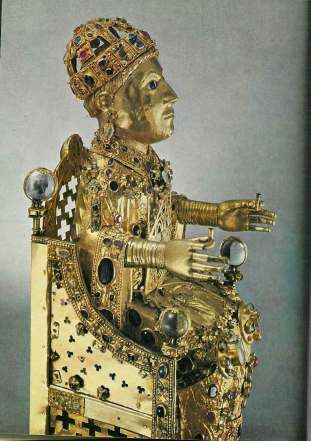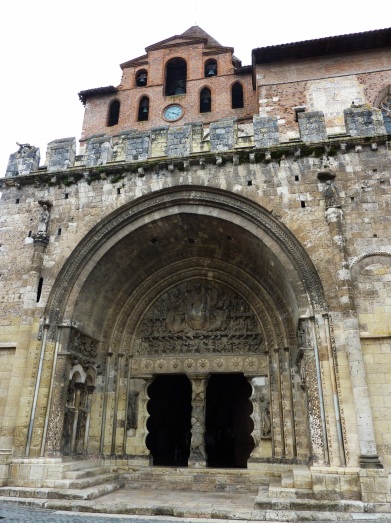The “iconographic shift”: The critical 11th and 12th centuries.
Though never lacking from the Carolingian landscape, images nevertheless circulated subject to tight guidelines. Fresh figurative developments and a patent growth in their circulation led historians J-C Schmitt and Jérôme Baschet to refer to a pivotal “iconographic shift” in the 10th and 11th century. Then images broke free from monastic and cathedral treasuries to make a stand outside and be beholden on church facades or in their fretwork. Coming closer to the faithful, images became more common, more popular – devised to be seen and displayed for what they are. Doctrinal thinking kept within the framework spelt out by Gregory and in keeping with a toned down interpretation of the Libri Carolini. It mainly focussed on the relation between image, cult and veneration. But this position endured as if disconnected from figuration practices and never actually bore on the formal aspects of image making or representational criteria. Unlike what was going on in Byzantium, the clerical normative interference regarding image production was light-touch or inexistent. Active craftsmen enjoyed the broadest freedom.
One of the earliest examples of this new form of devotion is St Foy's golden Reliquary in the abbey church of Conques [doc 13]. The artefact is a composite, the current shape of which is ascribed to a major restoration conducted circa 985, with a view to bestow on it the aura required to attract pilgrims. The artefact was originally a reliquary containing a skull fragment in its bust. This approach to legitimating a type of representation enjoying a broad public following helped overcome the reservations of some clerics. The evidence of Bernard, scholaster of the Cathedral of Angers suggests this was then a novel phenomenon. He visited Conques in 1010, to investigate the miracles attributed to Saint Foy and the prodigies effected by her statue, which he was comparing to pagan idols. At first deeply sceptical and shocked by what he considered idolatrous, he was nevertheless, thanks to a dream he deemed miraculous, soon persuaded of the advantages of the format: there could be no better medium to engage the interest of the faithful. Thus become an unconditional advocate, he drafted the first collection of St Foy's miracles (the Book of Miracles of Sainte Foi).

 Informations[1]
Informations[1]
 Informations[2]
Informations[2]This expansion in the representation and even more the propagation of images was matched by a gradual diversification of themes, supports and techniques. The field of statuary is particularly representative of this trend. The earliest types of sculpted decoration in churches at the beginning of the 11th century were still purely ornamental: geometric fretwork soon to be augmented with vegetal themes, whereupon human figures made their appearance, for instance in the lintel of Saint Génis des Fontaines Abbey (Roussillon) [doc 14]. Only in a second phase, at the very end of the 11th century would sculpture play a greater part. Great sculpted tympani [doc 15] and capitals then flourished which would be the glory of Romanesque art before decorations made increasing inroads all over the wall surfaces until they completely covered them. Yet this booming figuration fairly kept to the Gregorian and Carolingian tradition. Primarily intended for the illiterate worshipers, always tied in with Scripture and the worship of saints and relics, images remained a lesser substitute for the Sacred Text. However everyday practices influenced the attitude of Church authorities. In the footsteps of Bernard of Angers, the clergy had no qualms in overseeing this trend, along Gregory the Great's lines: images must teach, remind, move; they must be a support, a prop to prayer.
 Informations[3]
Informations[3]
 Informations[4]
Informations[4]
 Informations[5]
Informations[5]Theological thinking bears the mark of this practice driven shift, which coincided with the rediscovery of Aristotelian metaphysics. Thomas Aquinas' works were party to a sort of rehabilitation: in and by itself an image was but an object and fashioning one is not an offense; it was the use made of it that would define its legitimacy or its unacceptability. Worshiping a material image belonged with superstition; but the image was also representation of its original model in that it “made present”. As such, it would become as valid as the original model. Thomas Aquinas[6] offered a new understanding of the Old Testament prohibition: it is not so much the making of images per se that was forbidden as the idolatrous veneration of “false gods”. Paramount is the object of worship: pagan figures are condemned, the figuration of Christ worthy of praise. In this he was elaborating a theory wherein the intentionality of the image takes precedent on all else: the intention of the image decides of its validity and paves the way to a joint and, to all intends and purposes, indistinct veneration of the model and the image corresponding to what it represents. In this he adopted more radical bases [doc 16] than those set by the second Council of Nicaea. The 13th century marks a watershed in figurative art when the rehabilitation of figuration was total, attended by an extraordinary propagation of images throughout 12th and 13th century Latin Christendom.







